Great Sphinx of Giza
The Great Sphinx of Giza, commonly referred to as the Sphinx of Giza or just the Sphinx, is a limestone statue of a reclining sphinx, a mythical creature with the body of a lion and the head of a human. Facing directly from West to East, it stands on the Giza Plateau on the west bank of the Nile in Giza, Egypt. The face of the Sphinx is generally believed to represent the Pharaoh Khafre.
Cut from the bedrock, the original shape of the Sphinx has been restored with layers of blocks. It measures 238 feet (73 m) long from paw to tail, 66.3 ft (20.21 m) high from the base to the top of the head and 62.6 feet (19 m) wide at its rear haunches. It is the oldest known monumental sculpture in Egypt and is commonly believed to have been built by ancient Egyptians of the Old Kingdom during the reign of the Pharaoh Khafre (c. 2558–2532 BC).
Origin
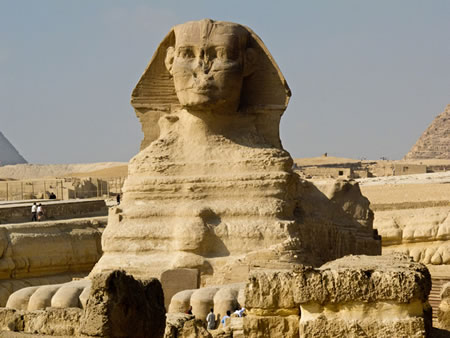 The Great Sphinx is one of the world's largest and oldest statues, but basic facts about it are still subject to debate, such as when it was built, by whom and for what purpose. These questions have resulted in the popular idea of the "Riddle of the Sphinx," alluding to the original Greek legend of the "Riddle of the Sphinx."
The Great Sphinx is one of the world's largest and oldest statues, but basic facts about it are still subject to debate, such as when it was built, by whom and for what purpose. These questions have resulted in the popular idea of the "Riddle of the Sphinx," alluding to the original Greek legend of the "Riddle of the Sphinx."
First century writer Pliny the Elder mentioned the Great Sphinx in his Natural History, commenting that the Egyptians looked upon the statue as a "divinity" that has been passed over in silence and "that King Harmais was buried in it."
Names of the Sphinx
It is impossible to identify what name the creators called their statue, as the Great Sphinx does not appear in any known inscription of the Old Kingdom and there are no inscriptions anywhere describing its construction or its original purpose. In the New Kingdom, the Sphinx was called Hor-em-akhet (English: Horus of the Horizon; Hellenized: Harmachis), and the pharaoh Thutmose IV (1401–1391 or 1397–1388 BC) specifically referred to it as such in his "Dream Stele."
The commonly used name "Sphinx" was given to it in classical antiquity, about 2000 years after the commonly accepted date of its construction by reference to a Greek mythological beast with a lion's body, a woman's head and the wings of an eagle (although, like most Egyptian sphinxes, the Great Sphinx has a man's head and no wings). The English word sphinx comes from the ancient Greek Σφίγξ (transliterated: sphinx) apparently from the verb σφίγγω (transliterated: sphingo / English: to squeeze), after the Greek sphinx who strangled anyone who failed to answer her riddle.
Builder and Timeframe
Though there have been conflicting evidence and viewpoints over the years, the view held by modern Egyptology at large remains that the Great Sphinx was built in approximately 2500 BC for the pharaoh Khafra, the builder of the Second Pyramid at Giza.
Selim Hassan, writing in 1949 on recent excavations of the Sphinx enclosure, summed up the problem:
Taking all things into consideration, it seems that we must give the credit of erecting this, the world's most wonderful statue, to Khafre, but always with this reservation: that there is not one single contemporary inscription which connects the Sphinx with Khafre; so, sound as it may appear, we must treat the evidence as circumstantial, until such time as a lucky turn of the spade of the excavator will reveal to the world a definite reference to the erection of the Sphinx.
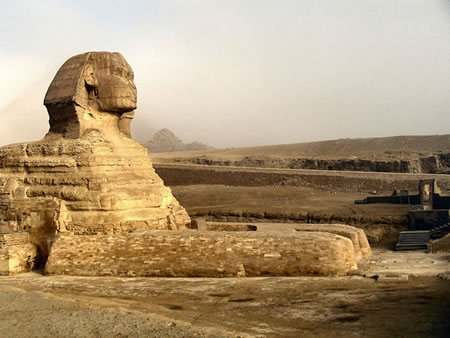 The "circumstantial" evidence mentioned by Hassan includes the Sphinx's location in the context of the funerary complex surrounding the Second Pyramid, which is traditionally connected with Khafra.[16] Apart from the Causeway, the Pyramid and the Sphinx, the complex also includes the Sphinx Temple and the Valley Temple, both of which display the same architectural style, with 200-tonne stone blocks quarried out of the Sphinx enclosure.
The "circumstantial" evidence mentioned by Hassan includes the Sphinx's location in the context of the funerary complex surrounding the Second Pyramid, which is traditionally connected with Khafra.[16] Apart from the Causeway, the Pyramid and the Sphinx, the complex also includes the Sphinx Temple and the Valley Temple, both of which display the same architectural style, with 200-tonne stone blocks quarried out of the Sphinx enclosure.
A diorite statue of Khafre, which was discovered buried upside down along with other debris in the Valley Temple, is claimed as support for the Khafra theory.
The Dream Stele, erected much later by the pharaoh Thutmose IV (1401–1391 or 1397–1388 BC), associates the Sphinx with Khafra. When the stele was discovered, its lines of text were already damaged and incomplete, and only referred to Khaf, not Khafra. An extract was translated:
which we bring for him: oxen ... and all the young vegetables; and we shall give praise to Wenofer ... Khaf ... the statue made for Atum-Hor-em-Akhet.
The Egyptologist Thomas Young, finding the Khaf hieroglyphs in a damaged cartouche used to surround a royal name, inserted the glyph ra to complete Khafra's name. When the Stele was re-excavated in 1925, the lines of text referring to Khaf flaked off and were destroyed.
Dissenting Hypotheses
Theories held by academic Egyptologists regarding the builder of the Sphinx and the date of its construction are not universally accepted, and various persons have proposed various alternative hypotheses about both the builder and the dating.
Early Egyptologists
Some early Egyptologists and excavators of the Giza pyramid complex believed the Great Sphinx and associated temples to predate the fourth dynasty rule of Khufu, Khafre, and Menkaure. Petrie wrote in 1883 regarding the state of opinion regarding the age of the nearby temples, and by extension the Sphinx: "The date of the Granite Temple [Valley Temple] has been so positively asserted to be earlier than the fourth dynasty, that it may seem rash to dispute the point".
In 1857, Auguste Mariette, founder of the Egyptian Museum in Cairo, unearthed the much later Inventory Stela (estimated Dynasty XXVI, c. 678–525 BC), which tells how Khufu came upon the Sphinx, already buried in sand. Although certain tracts on the Stela are considered good evidence, this passage is widely dismissed as Late Period historical revisionism, a purposeful fake, created by the local priests with the attempt to certify the contemporary Isis temple an ancient history it never had. Such an act became common when religious institutions such as temples, shrines and priest's domains were fighting for political attention and for financial and economic donations.
Gaston Maspero, the French Egyptologist and second director of the Egyptian Museum in Cairo, conducted a survey of the Sphinx in 1886. He concluded that because the Dream stela showed the cartouche of Khafre in line thirteen, that it was he who was responsible for the excavation and that the Sphinx must therefore predate Khafre and his predecessors (i.e. Dynasty IV, c. 2575–2467 BC). English Egyptologist E. A. Wallis Budge agreed that the Sphinx predated Khafre's reign, writing in The Gods of the Egyptians (1914): "This marvelous object [the Great Sphinx] was in existence in the days of Khafre, or Khephren, and it is probable that it is a very great deal older than his reign and that it dates from the end of the archaic period [c. 2686 BC]." Maspero believed the Sphinx to be "the most ancient monument in Egypt".
Modern Dissenting Hypotheses
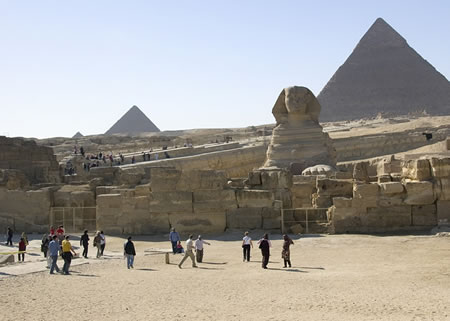 Rainer Stadelmann, former director of the German Archaeological Institute in Cairo, examined the distinct iconography of the nemes (headdress) and the now-detached beard of the Sphinx and concluded that the style is more indicative of the Pharaoh Khufu (2589–2566 BC), builder of the Great Pyramid of Giza and Khafra's father. He supports this by suggesting that Khafra's Causeway was built to conform to a pre-existing structure, which, he concludes, given its location, could only have been the Sphinx.
Rainer Stadelmann, former director of the German Archaeological Institute in Cairo, examined the distinct iconography of the nemes (headdress) and the now-detached beard of the Sphinx and concluded that the style is more indicative of the Pharaoh Khufu (2589–2566 BC), builder of the Great Pyramid of Giza and Khafra's father. He supports this by suggesting that Khafra's Causeway was built to conform to a pre-existing structure, which, he concludes, given its location, could only have been the Sphinx.
Colin Reader, an English geologist who independently conducted a more recent survey of the enclosure, agrees that the various quarries on the site have been excavated around the Causeway. Because these quarries are known to have been used by Khufu, Reader concludes that the Causeway (and the temples on either end thereof) must predate Khufu, thereby casting doubt on the conventional Egyptian chronology.
Frank Domingo, a forensic scientist in the New York City Police Department and an expert forensic anthropologist, used detailed measurements of the Sphinx, forensic drawings and computer imaging to conclude that the face depicted on the Sphinx is not the same face as is depicted on a statue attributed to Khafra.
In 2004, Vassil Dobrev of the Institut Français d'Archéologie Orientale in Cairo announced that he had uncovered new evidence that the Great Sphinx may have been the work of the little-known Pharaoh Djedefre (2528–2520 BC), Khafra's half brother and a son of Khufu. Dobrev suggests that Djedefre built the Sphinx in the image of his father Khufu, identifying him with the sun god Ra in order to restore respect for their dynasty. Dobrev also notes, like Stadelmann and others, that the causeway connecting Khafre's pyramid to the temples was built around the Sphinx suggesting it was already in existence at the time.
Orion Correlation Theory
The Orion correlation theory, as expounded by popular authors Graham Hancock and Robert Bauval, is based on the proposed exact correlation of the three pyramids at Giza with the three stars ζ Ori, ε Ori and δ Ori, the stars forming Orion's Belt, in the relative positions occupied by these stars in 10500 BC. The authors argue that the geographic relationship of the Sphinx, the Giza pyramids and the Nile directly corresponds with Leo, Orion and the Milky Way respectively. The theory is at variance with mainstream scholarship.
Water Erosion Hypothesis
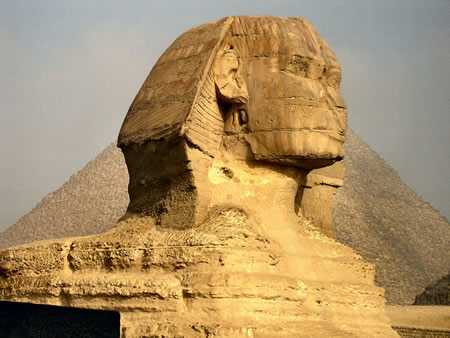 The Sphinx water erosion hypothesis contends that the main type of weathering evident on the enclosure walls of the Great Sphinx could only have been caused by prolonged and extensive rainfall, and that it must therefore predate the time of the pharaoh Khafra. The hypothesis is championed primarily by Robert M. Schoch, a geologist and associate professor of natural science at the College of General Studies at Boston University, and John Anthony West, an author and alternative Egyptologist.
The Sphinx water erosion hypothesis contends that the main type of weathering evident on the enclosure walls of the Great Sphinx could only have been caused by prolonged and extensive rainfall, and that it must therefore predate the time of the pharaoh Khafra. The hypothesis is championed primarily by Robert M. Schoch, a geologist and associate professor of natural science at the College of General Studies at Boston University, and John Anthony West, an author and alternative Egyptologist.
Colin Reader, a British geologist, studied the erosion effects and noticed that the effects are selectively at the western enclosure wall and not on the Sphinx itself. He proposed the rainfall water runoff hypothesis, which also recognizes climate change transitions in the area.
Racial Characteristics
Over the years several authors have commented on what they perceive as "Negroid" characteristics in the face of the Sphinx. This issue has become part of the Ancient Egyptian race controversy, with respect to the ancient population as a whole. The face of the Sphinx has been damaged over the millennia.
Restoration
At some unknown time the Giza Necropolis was abandoned, and the Sphinx was eventually buried up to its shoulders in sand. The first documented attempt at an excavation dates to c. 1400 BC, when the young Thutmose IV (1401–1391 or 1397–1388 BC) gathered a team and, after much effort, managed to dig out the front paws, between which he placed a granite slab, known as the Dream Stele, inscribed with the following (an extract):
...the royal son, Thothmos, being arrived, while walking at midday and seating himself under the shadow of this mighty god, was overcome by slumber and slept at the very moment when Ra is at the summit [of heaven]. He found that the Majesty of this august god spoke to him with his own mouth, as a father speaks to his son, saying: Look upon me, contemplate me, O my son Thothmos; I am thy father, Harmakhis-Khopri-Ra-Tum; I bestow upon thee the sovereignty over my domain, the supremacy over the living ... Behold my actual condition that thou mayest protect all my perfect limbs. The sand of the desert whereon I am laid has covered me. Save me, causing all that is in my heart to be executed.
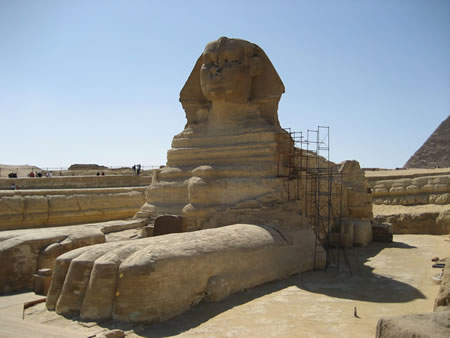 Later, Ramesses II the Great (1279–1213 BC) may have undertaken a second excavation.
Later, Ramesses II the Great (1279–1213 BC) may have undertaken a second excavation.
Mark Lehner, an Egyptologist who has excavated and mapped the Giza plateau, originally asserted that there had been a far earlier renovation during the Old Kingdom (c. 2686–2184 BC), although he has subsequently recanted this "heretical" viewpoint.
In AD 1817 the first modern archaeological dig, supervised by the Italian Giovanni Battista Caviglia, uncovered the Sphinx's chest completely.
One of the people working on clearing the sands from around the Great Sphinx was Eugène Grébaut, a French Director of the Antiquities Service "In the beginning of the year 1887, the chest, the paws, the altar, and plateau were all made visible. Flights of steps were unearthed, and finally accurate measurements were taken of the great figures. The height from the lowest of the steps was found to be one hundred feet, and the space between the paws was found to be thirty-five feet long and ten feet wide. Here there was formerly an altar; and a stele of Thûtmosis IV was discovered, recording a dream in which he was ordered to clear away the sand that even then was gathering round the site of the Sphinx."
The entire Sphinx was finally excavated in 1925 to 1936, in digs led by Émile Baraize.
In 1931 engineers of the Egyptian government repaired the head of the Sphinx. Part of its headdress had fallen off in 1926 due to erosion, which had also cut deeply into its neck.
Gallery
More Video
Megalithic Builders is an index of ancient sites from around the world that contain stone megaliths or interlocking stones. Genus Dental Sacramento

